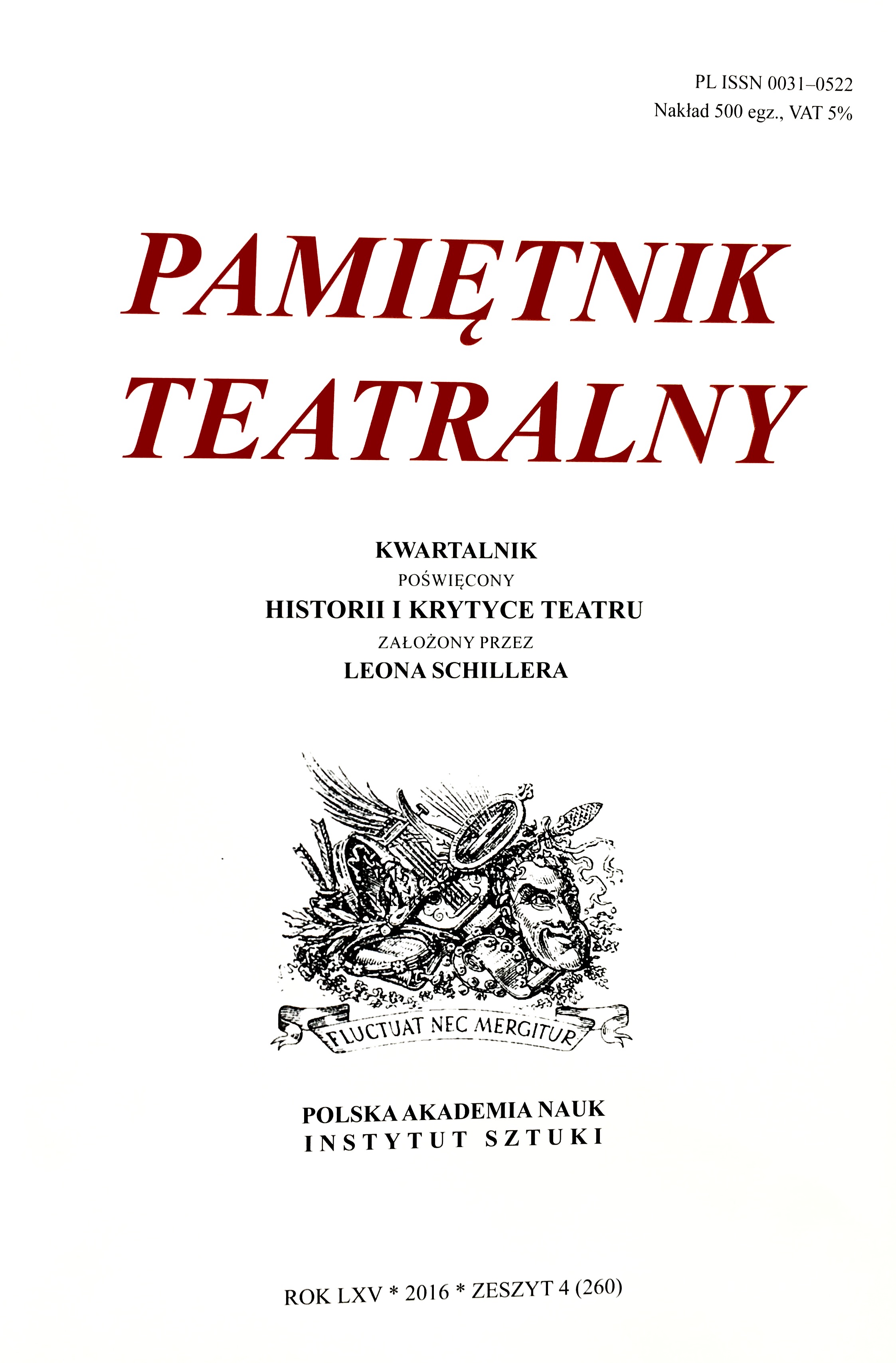Cztery noty o Witkacym
Four Notes on Witkacy
Author(s): Janusz DeglerSubject(s): Theatre, Dance, Performing Arts
Published by: Instytut Sztuki Polskiej Akademii Nauk
Keywords: Witkacy;
Summary/Abstract: The monographic issue of Pamiętnik Teatralny (1985, vols 1–4) devoted to S. I. Witkiewicz on the centennial of his birth, an occasion noted in the UNESCO Calendar of Anniversaries of Great Personalities and Events, featured a text by Jan Kott which comprised six Notes. Each of them had a title and indicated possible sources of inspiration of some works, i.a. The Water Hen, which is ridden with motifs characteristic for modernist dramaturgy, e.g. Lulu by Frank Wedekind. Kott concluded his notes by asserting: “Witkacy the modernist, the historical, anachronistic and decadent one, is still waiting for his director and for his appearance on stage.” It has been fifteen years since Jan Kott passed away on 23 December 2001. These four notes have been written in his memory. 1. Did Witkacy Intend to Return to the Tropics? On 9 April 1918, Maria Witkiewiczowa, Witkacy’s mother, sent a postcard to her friend, Leon Chwistek’s sister, reporting that she had received a letter from her son in Petrograd with the news that he was planning “to return to Poland or to travel to Sumatra.” Enclosed with the letter was the now famous “Multiple Portrait” photograph. Witkacy’s travel with Bronisław Malinowski to the tropics, which began in June 1914 and ended in October of the same year when Witkacy arrived in Petrograd, was an important experience for Witkacy and influenced his painting and other creative work (stories of several of his plays were set in the tropics). Though fascinated with tropical wildlife and nature, like Gauguin and several other artists, he decided not to go to Sumatra; instead, he returned to Poland in July 1918 and described his Ceylon experiences in the reportage “Podróż do Tropików” (‘A Voyage to the Tropics’) that appeared in Echo Tatrzańskie (1919). 2. The Puzzle of Prologue to Pentemychos i Jej Niedoszły Wychowanek The Jadwiga Witkiewiczowa archive contains a single page with a German-language piece of verse which is a fragment of the prologue of the now lost play Pentemychos i Jej niedoszły wychowanek (‘Pentemychos and Her Would-be Pupil’). Witkacy wrote it at the beginning of 1920 and sent its copy to Jarosław Iwaszkiewicz in September 1921 suggesting that it be put on for the opening of the Elsynor Theatre founded by members of the Skamander group. There was, however, no actress to perform the “wonderful female part,” and only the premiere of The Pragmatists took place (29 Dec. 1921). In 1922, while in Zakopane, Witkacy met Ms. Eckert of Hamburg; he gave her a copy of The Water Hen, and she promised to recommend it to a theatre producer in Hamburg. Probably the hope for success of her mission spurred Witkacy to entrust one of his friends with translating Pentemychos i Jej niedoszły kochanek into German. The anticipated Hamburg premiere never panned out. The surviving fragment of the Prologue is probably a part of the aforementioned translation. 3. Witkacy “Honeycombed with Childishness,” or a DIY Way of Improving One’s Kaleidoscope Witkacy had a great sense of humour and exceptional acting talents; he liked putting on a show to spice things up for himself and his friends; he had been known to surprise those around him by making “monstrous faces” and acting in an unconventional way. He had been a passionate collector since childhood. He collected walking sticks and various curios, which he put in his “albums of curiosities.” He was always on the lookout for fun. His favourite toy was a kaleidoscope. He wrote a detailed manual on how to improve it so that anyone could change the images it produced whenever they liked. 4. Grotowski and Witkacy As a student of the Cracow theatre school, Jerzy Grotowski planned to put on The Shoemakers at Wawel in the school year of 1958-59. The school authorities did not approve, and as a result, Grotowski dropped out of school and went to Opole where he became the artistic manager of the 13 Rzędów Theatre. In his first productions, he harked back to the tradition of the Romantics and to Witkacy (i.a. in Kain). When the editorial board of Teatr asked him whose portrait he would hang up in his directorial office, Grotowski replied that it would be of four “martyrs” of the theatre: Artaud, Witkacy, Meyerhold, and Stanislavsky. He was also interested in Witkacy’s theatrical experiences during his stay in Russia in 1914–1918. This issue is, however, still open, requiring archival research.
Journal: Pamiętnik Teatralny
- Issue Year: 260/2016
- Issue No: 4
- Page Range: 113-139
- Page Count: 27
- Language: Polish

